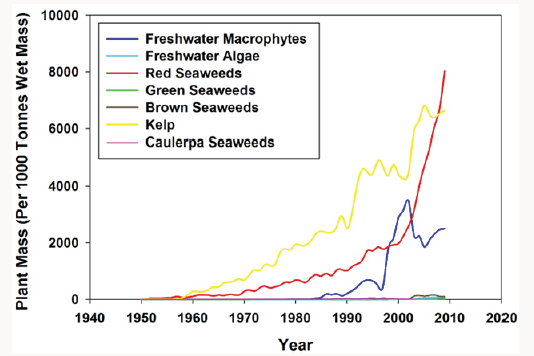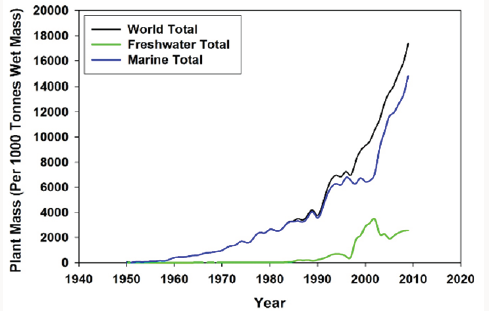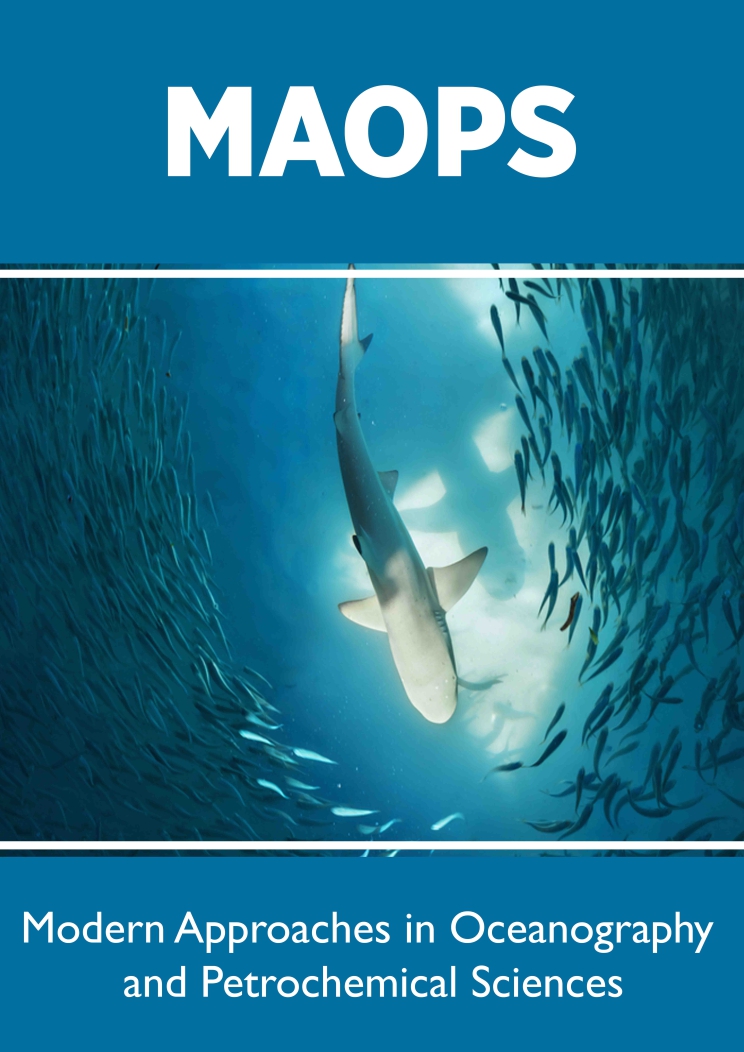
Lupine Publishers Group
Lupine Publishers
Menu
ISSN: 2637-6652
Review Article(ISSN: 2637-6652) 
Economic Benefits of Aquatic Plants - A Review Volume 1 - Issue 3
B Sakthinathan*
- Assistant Professor, School of Agriculture and Biosciences, Karunya Institute of Technology and Sciences, Coimbatore, Tamil Nadu, India
Received: April 11, 2018; Published: April 25, 2018
Corresponding author: B Sakthinathan, Assistant Professor, School of Agriculture and Biosciences, Karunya Institute of Technology and Sciences, Coimbatore, Tamil Nadu, India
DOI: 10.32474/MAOPS.2018.01.000115
Abstract
Aquatic plants are actual significant customs of plant life and are essential component of the aquatic biome. A variety of products and considerable beneficial services are offered by this group of organisms. They play a vital role in the life of human beings as food, fodder, medicine, etc. In spite of that, the knowledge about correct utilization of aquatic plants is lacking among common people and in order to make them aware, steps are to be introduced. This paper concise about the economic and significant benefits of aquatic plants for the welfare of humanitarian.
Keywords: Aquatic; plants; Weeds; Water; Marine
Introduction
Describing an aquatic plant is more difficult than understanding what is meant by the term; because both terms (‘aquatic’ and ‘plant’) are used, which encompass a different set terminology than when each term is used alone. In this document we will use aquatic in the broader sense of environments defined by possessing seasonal or permanent standing water, both freshwater and marine. The, environments discussed, therefore, will be lakes, rivers, ponds, estuaries and oceans. By plant, we will refer to microscopic and macroscopic photosynthetic organisms, both vascular and nonvascular. The term aquatic plant is used much like the term aquatic macrophyte - plants visible to the unaided eye. Therefore, this will include flowering plants, conifers, mosses, ferns and fern allies, charophytes, macro-algae of all descriptions, and any other plant found in standing or moving water. We will discuss plants that are completely submersed, rooted in the sediment with leaves floating on the surface, plants rooted in standing water with leaves emerging from the water, and plants that are free-floating in the water with leaves either submersed, or partly or fully emergent. Algal growth forms will include free floating phytoplankton and algae that grow attached to a variety of substrates. The difficulty of defining ‘aquatic plants’ has been discussed more thoroughly by Sculthorpe (1967). The purpose of this report is to discuss both potential hazards to the growing of plants that are beneficial to human uses, whether cultivated or uncultivated, or strictly for their ecosystem benefits, and aquatic plants that pose a potential to interfere with agriculture. The scope of habitats for this survey will include freshwater, brackish water and marine environments.
Economic Benefits of Aquatic Plants
The demand for aquatic plants, primarily marine macro-algae has increased exponentially over the past few decades. Global harvests of aquatic plants in 2009 were roughly 17 million tonnes with marine algae comprising > 85 percent of this total (Figure 1). Kelp has historically been the class of marine algae harvested in the greatest volume with peak harvests occurring from 2004 to 2009 at > 6 million tons (Figure 2). However in 2009, the harvest of red algae surpassed kelp by approximately 2 million tons (Figure 2). Countries contributing the majority of wild harvested macro-algae include China, Chile, Norway, Japan, and Russia (FAO, 2010). Macroalgae production as a result of aquaculture is greatest in China followed by Indonesia, the Philippines, Korea, Japan, Malaysia and Viet Nam [1-4].
Figure 2: The global harvest of marine and freshwater aquatic plants by taxa group from 1950 to 2009.

The harvest of freshwater plants has been relatively minimal ranging from no reported harvest from 1950 to 1966, to a harvest of over 2 million tonnes per year in the last decade. The sharp increase in marine aquatic plant harvests probably is the result of increased demand from the food, pharmaceutical, and biomass feedstock; whereas the increase in freshwater plant harvests is possibly driven by increased popularity of water gardening and aquarium plantings. Many of the most popular water garden species are imported from tropical and subtropical regions. Since 1990, the global value of aquatic plants has been between.com$4 8 billion, with a peak in 2007 at > US$7 billion.
The high-value of Caulerpa seaweed is a result of its popularity in the aquarium industry. The decline in value after 2007 is probably attributed to Caulerpa taxifolia being placed on the list of 100 of the World’s Worst Invasive Alien Species published by the Invasive Species Specialist Group (ISSG). Sales of Caulerpa varieties have likely been banned in a number of countries and thus the global value has decreased. Generally, however, human consumption of macro-algae (Nori, aonori, kombu, wakame, etc.) remains the primary use with an estimated global value in 2003 of.com$5 billion [3]. After human food uses, macro-algae hydrocolloids comprise the next largest segment of the aquatic plant industry. In 2009, the hydrocolloid industry was estimated at.com$1.02 billion with carrageenan’s comprising.com$527 million followed by alginates US$318million, and agar.com$173 million [1]. Other major macroalgae uses include fertilizers and conditioners.com$5 million; and animal feed.com$5 million [3].
Conclusion
The benefits of aquatic plants to people are far reaching with many new uses yet to be discovered. Currently, however, both marine and freshwater habitats are being threatened by the introduction of aquatic plant species that become problematic under certain conditions. These plant species are often introduced from other parts of the world for beneficial or horticultural uses, and then escape cultivation to form natural populations.
References
- Bixler J H and Porse H ( 2011) A decade of change in the sea weed hydrocolloids industry. Journal of Applied Phycology 23(3): 321-335.
- FAO (2010) 2008 Fishery and Aquaculture Statistics. Rome, Italy, p 72.
- McHugh D J (2003) A guide to the seaweed industry, Fisheries Technical Paper 441, Rome, Italy, pp. 105.
- Sculthorpe CD (1967) The biology of aquatic vascular plants. London, Edward Arnold, pp. 610.

Top Editors
-

Mark E Smith
Bio chemistry
University of Texas Medical Branch, USA -

Lawrence A Presley
Department of Criminal Justice
Liberty University, USA -

Thomas W Miller
Department of Psychiatry
University of Kentucky, USA -

Gjumrakch Aliev
Department of Medicine
Gally International Biomedical Research & Consulting LLC, USA -

Christopher Bryant
Department of Urbanisation and Agricultural
Montreal university, USA -

Robert William Frare
Oral & Maxillofacial Pathology
New York University, USA -

Rudolph Modesto Navari
Gastroenterology and Hepatology
University of Alabama, UK -

Andrew Hague
Department of Medicine
Universities of Bradford, UK -

George Gregory Buttigieg
Maltese College of Obstetrics and Gynaecology, Europe -

Chen-Hsiung Yeh
Oncology
Circulogene Theranostics, England -
.png)
Emilio Bucio-Carrillo
Radiation Chemistry
National University of Mexico, USA -
.jpg)
Casey J Grenier
Analytical Chemistry
Wentworth Institute of Technology, USA -
Hany Atalah
Minimally Invasive Surgery
Mercer University school of Medicine, USA -

Abu-Hussein Muhamad
Pediatric Dentistry
University of Athens , Greece

The annual scholar awards from Lupine Publishers honor a selected number Read More...












